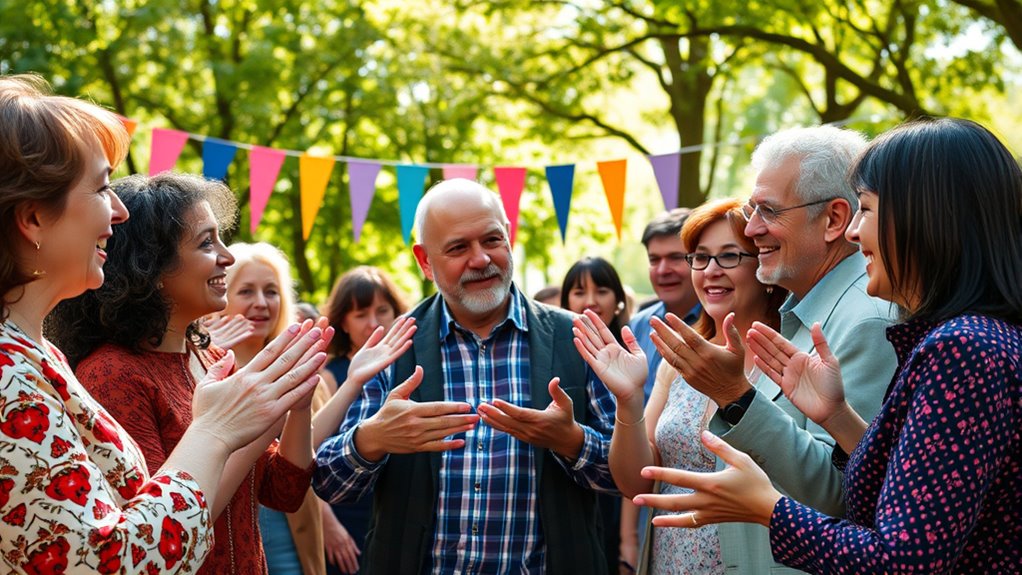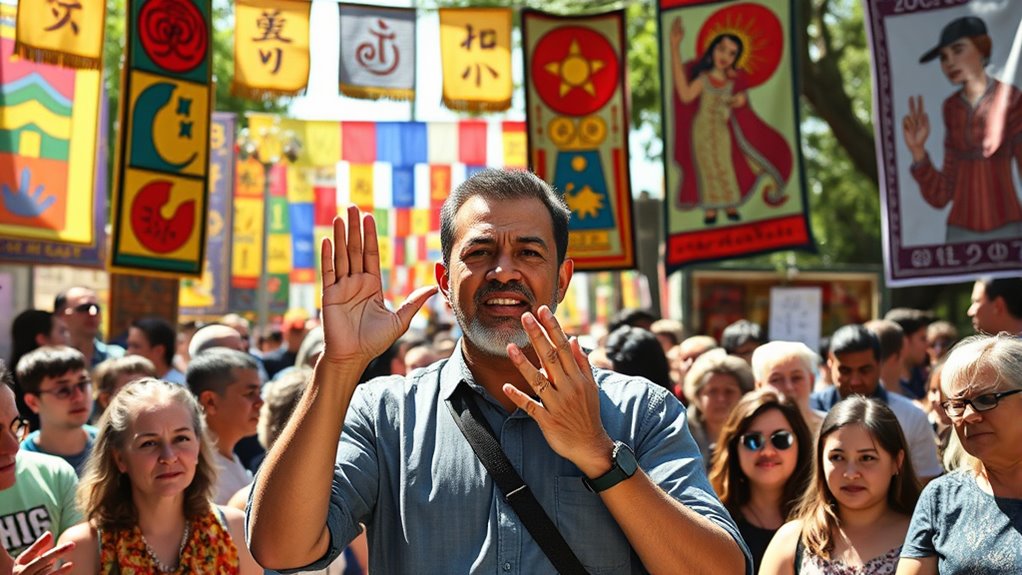ASL plays a central role in shaping your Deaf identity by serving as both a language and an essential cultural expression. It connects you to a community that shares traditions, stories, and values, fostering pride and belonging. Through ASL, you pass down heritage and maintain cultural continuity while expressing yourself artistically and socially. If you want to understand how ASL empowers Deaf individuals and preserves their culture, keep exploring this fascinating topic.
Key Takeaways
- ASL serves as a core marker of Deaf cultural identity and community belonging.
- It facilitates passing down Deaf heritage, stories, and traditions across generations.
- Using ASL enhances self-esteem, pride, and authentic self-expression within Deaf communities.
- Recognition of ASL as a legitimate language affirms Deaf identity and promotes societal inclusion.
- ASL strengthens community bonds and activism, fostering collective pride and cultural preservation.
The Origins and Development of ASL

The origins of American Sign Language (ASL) trace back to the early 19th century when French Sign Language (LSF) and regional sign languages used in American Deaf communities merged. This blending formed the foundation of ASL, which was later formalized by Thomas Gallaudet, Laurent Clerc, and others at the American School for the Deaf in 1817. Standardized communication methods helped solidify ASL’s role in Deaf education and community cohesion. Throughout its history, ASL has played a crucial role in shaping Deaf culture, serving not only as a means of communication but also as a core part of community identity. Despite suppression during the 19th and early 20th centuries, recognition grew in the 1960s thanks to linguistic research that demonstrated its complexity. The development of ASL also reflects broader linguistic diversity within the Deaf community worldwide. This linguistic richness is recognized as a vital element of Deaf cultural identity, fostering pride and resilience among Deaf individuals. Additionally, the increased understanding of ASL’s linguistic structure has contributed to the recognition of signed languages as legitimate languages in their own right. The recognition of ASL as a distinct language has also contributed to increased cultural pride among Deaf individuals.
How ASL Shapes Personal Identity Within the Deaf Community

When you use ASL, you become more connected to the Deaf community and its cultural identity. Mastering the language boosts your confidence and helps you express yourself authentically. Through signing, you reinforce your sense of pride and personal belonging within Deaf culture. Recognizing the significance of cultural identity in the Deaf community further deepens your connection and understanding. Additionally, automation in business technologies have played a role in enhancing communication and accessibility for Deaf individuals, strengthening community bonds. Developing audiometric testing skills can also be valuable for those involved in hearing health, as it is essential for accurate diagnosis and differentiation of hearing loss types. Incorporating camping resources and guides can promote outdoor engagement and community participation among Deaf individuals, fostering shared experiences and cultural expression. Understanding Gold IRA fees and related topics can also empower you to make informed decisions, much like embracing your cultural identity enhances personal confidence and community bonds.
Language as Cultural Identity
Have you ever considered how language shapes your sense of who you are? ASL is a powerful marker of cultural identity, allowing Deaf individuals to express shared values, traditions, and community bonds.
When you learn and use ASL, you strengthen your connection to Deaf culture and foster a sense of belonging and pride. Proficiency in ASL helps you maintain cultural continuity and pass down Deaf heritage across generations.
Its unique linguistic structure enables you to communicate nuanced cultural experiences that spoken languages can’t capture. The more fluent you become in ASL, the stronger your identification with Deaf culture, boosting your self-esteem and reinforcing your personal identity within the community.
Language isn’t just communication; it’s an essential part of who you’re as a Deaf person. Developing Cultural Intelligence about Deaf culture can deepen your understanding and appreciation of the community’s shared values and practices.
Sign Language Pride
Ever wonder how some Deaf individuals radiate confidence and pride when they sign? That’s sign language pride in action. Mastering ASL allows you to express your cultural identity authentically, fostering a strong sense of belonging. When you communicate fluently, you show resilience against historical suppression, symbolizing Deaf culture’s resilience. Your ASL recognition boosts self-esteem and challenges misconceptions about Deafness. Here’s a deeper look:
| Sign Language Pride | Deaf Culture | ASL Recognition |
|---|---|---|
| Reflects cultural resilience | Celebrates heritage | Validates Deaf identity |
| Builds community bonds | Fosters belonging | Enhances self-worth |
| Challenges stereotypes | Preserves traditions | Promotes inclusivity |
| Emphasizes authenticity | Strengthens connections | Encourages pride |
| Spurs activism | Reinforces identity | Celebrates diversity |
Recognizing ASL as a vital aspect of cultural identity further affirms its importance within the community. Being fluent in ASL not only improves communication but also plays a crucial role in language preservation, ensuring that this vital aspect of Deaf culture endures for future generations. Additionally, increasing ASL recognition can help combat ongoing misconceptions and improve accessibility in various societal contexts. Developing a strong ASL identity also empowers individuals to advocate for Deaf rights, fostering societal change and greater inclusion. Moreover, fostering community engagement through ASL can strengthen support networks and promote collective activism.
Self-Expression Through ASL
ASL serves as a powerful tool for self-expression, allowing Deaf individuals to convey their thoughts, emotions, and cultural identity with authenticity. Through sign language, you can share personal stories and experiences that deepen your connection to Deaf culture. Mastering ASL enhances your confidence and pride, helping you embrace your true self within the community. Using sign language in daily interactions lets you participate actively in cultural practices, ceremonies, and artistic expressions that shape your identity. When you communicate fluently in ASL, you affirm your place in the Deaf community and reinforce your sense of belonging. Self-expression through ASL is essential for cultivating a strong personal and cultural identity, empowering you to live authentically within Deaf culture. Recognizing the importance of language proficiency can significantly impact how effectively you express yourself and connect with others, especially considering how vertical storage solutions can help create an organized environment that fosters confidence and clarity.
The Impact of ASL on Cultural Transmission and Heritage

ASL plays a vital role in passing down traditions and cultural stories within the Deaf community. By sharing folklore and narratives through sign language, you help keep Deaf heritage alive for future generations. This ongoing transmission strengthens cultural identity and fosters community pride. Additionally, ASL’s rich vocabulary and expressive gestures serve as a cultural archive, preserving historical and social knowledge unique to Deaf culture. Because of its expressive nature, ASL also facilitates intergenerational storytelling, ensuring that stories and values continue to resonate within the community. The visual and dynamic qualities of ASL make it an effective tool for cultural preservation, allowing traditions to be conveyed vividly and accurately across generations.
Passing Down Traditions
Sign language plays a vital role in preserving and transmitting Deaf traditions, stories, and cultural practices across generations. Through sign language, Deaf culture remains alive, with shared history, folklore, and values passed down within the community.
It acts as a living archive, ensuring that cultural practices and rituals stay vibrant and accessible to younger members. The continuity of ASL helps maintain the richness of Deaf heritage, fostering a strong sense of identity and pride.
Educational programs and community events using ASL further support the ongoing transmission of these traditions, connecting generations and reinforcing their cultural roots. By keeping these practices alive through sign language, you help preserve the unique heritage that shapes Deaf identity today.
Preserving Cultural Narratives
Passing down traditions is essential for keeping Deaf culture alive, and at its heart is the preservation of cultural narratives. ASL plays a vital role in transmitting shared history, folklore, and collective experiences that shape Deaf heritage. Utilizing ASL in storytelling and cultural practices ensures that these narratives are culturally significant and accessible to future generations. When you use ASL to tell stories, perform poetry, or participate in cultural rituals, you help maintain linguistic continuity, guaranteeing these narratives remain vibrant across generations. This language captures the values and memories that define the Deaf community, reinforcing a sense of identity and belonging. Regular use of ASL in cultural contexts also supports linguistic preservation, which is crucial for sustaining Deaf identity over time. Engaging in storytelling traditions through ASL helps preserve cultural transmission and keeps the community’s shared experiences alive.
Sign Language as a Medium for Artistic and Literary Expression

Visual language becomes a powerful tool for artistic and literary expression within Deaf communities, allowing creators to communicate complex stories and emotions through movement, facial expressions, and spatial arrangements.
Sign language enables the development of visual poetry, storytelling, and theatrical performances that vividly reflect cultural narratives.
Deaf artists use sign language to craft innovative art forms that blend movement, facial cues, and spatial elements, enriching Deaf artistic expression.
These performances convey deep emotions and stories, strengthening cultural heritage.
Artistic works in sign language serve as essential expressions of identity, preserving traditions while showcasing the richness of Deaf culture.
Through visual poetry and performance, sign language helps keep cultural narratives alive and vibrant for future generations.
Building Community and Fostering Connections Through ASL

Using ASL helps you connect with others and build a strong sense of belonging.
When you communicate in ASL at social events, you create opportunities for genuine friendships and shared cultural experiences.
These interactions strengthen community bonds and foster trust among Deaf individuals.
Shared Language Bonds
Shared language bonds, like those formed through ASL, play an essential role in building a strong sense of community among Deaf individuals. When you share fluency in ASL, it creates a common ground that fosters meaningful and culturally rich communication.
These linguistic bonds strengthen the Deaf community by enabling authentic interactions and mutual understanding. In social settings, using ASL helps establish trust and deepens interpersonal connections, making everyone feel included and valued.
Cultural events and gatherings often revolve around ASL, further reinforcing community ties and collective identity. Proficiency in ASL allows you to participate fully in community activities, promoting social cohesion.
Ultimately, shared language forms the foundation for a vibrant, connected Deaf community rooted in mutual support and cultural pride.
Social Connection Opportunities
Building connections through ASL extends beyond individual conversations to encompass a wide range of social opportunities that strengthen the Deaf community. Using sign language in social settings helps you form deep friendships and develop a sense of belonging.
Community events like Deaf gatherings, sports tournaments, and cultural festivals use ASL to foster group cohesion and celebrate cultural pride.
Online platforms and social media groups in ASL allow you to connect globally, share experiences, and support one another regardless of distance.
Participating in sign language-based clubs and advocacy groups promotes community building through collaborative projects, discussions, and cultural celebrations.
These opportunities enable you to embrace your Deaf identity, strengthen social bonds, and contribute to a vibrant, connected Deaf community rooted in shared language and pride.
The Significance of ASL in Promoting Cultural Pride and Awareness

- Reinforcing community identity through shared language
- Elevating Deaf culture in mainstream media
- Supporting advocacy for ASL recognition
- Boosting confidence and belonging within the community
Historical Challenges and the Fight for Recognition of ASL

The fight for the recognition of ASL has been a long and challenging journey marked by significant obstacles. In the early 1900s, the oralism movement pushed lip-reading and speech training, actively suppressing ASL in schools for the Deaf. Society often considered ASL inferior to spoken language, leading to discrimination and marginalization of Deaf culture. Deaf individuals faced institutional barriers, including bans on signing, which hindered cultural and linguistic growth. Recognition of ASL as a legitimate language only gained momentum mid-20th century, challenging misconceptions. Legal milestones like the Americans with Disabilities Act of 1990 reinforced Deaf rights to use ASL and preserve their cultural identity. This table highlights key moments in this ongoing struggle:
| Year | Event | Impact |
|---|---|---|
| 1900s | Oralism movement dominates | Suppresses ASL in education |
| 1950s | Recognition begins | Challenges misconceptions |
| 1990 | ADA passes | Protects Deaf rights to ASL |
The Role of Media and Technology in Preserving ASL and Deaf Culture

- Increased media representation of Deaf stories
- Accessible ASL learning resources online
- Real-time communication via digital tools
- Greater cultural awareness through media
Together, media and technology play a crucial role in preserving ASL and Deaf culture today.
Contemporary Advocacy and the Future of ASL and Deaf Identity

Contemporary advocacy efforts are shaping the future of ASL and Deaf identity by actively promoting authentic representation and societal inclusion. Movements like #DeafTalent highlight the importance of Deaf individuals in media and leadership roles, pushing for recognition of their talents and contributions.
Policy reforms aim to secure legal recognition and funding for ASL programs, ensuring its preservation and accessibility for future generations. Community initiatives leverage technology and social media to celebrate Deaf culture, foster pride, and educate the broader society about ASL’s legitimacy.
Sustained activism is critical to advancing language access, educational equity, and societal inclusion. Collaboration among Deaf organizations, allies, and policymakers is essential to protect and elevate ASL’s cultural and linguistic significance worldwide, shaping a more inclusive future.
How ASL Enhances Inclusivity and Breaks Down Barriers

Advocacy efforts have highlighted the importance of recognizing ASL as a vibrant and legitimate language, which plays a vital role in fostering inclusivity. When ASL is acknowledged, communication becomes more accessible, allowing Deaf individuals to participate fully in social, educational, and professional settings.
Recognizing ASL fosters inclusivity and accessibility for Deaf individuals in all aspects of society.
This promotes a more inclusive environment where diverse voices are heard. Recognizing ASL also challenges stereotypes and misconceptions, encouraging respect for Deaf culture. Incorporating ASL into public services and media reduces barriers, making society more accepting.
To emphasize this, consider these points:
- Enhances accessibility in everyday interactions
- Empowers Deaf individuals through education and work
- Promotes cultural understanding and respect
- Breaks down communication barriers within society
Frequently Asked Questions
What Is the Role of Sign Language in Deaf Culture?
The current question asks about the role of sign language in Deaf culture. You should recognize that sign language is more than just a communication tool; it’s an essential part of cultural identity.
It helps you connect with others, share stories, and preserve traditions.
Using sign language affirms your community’s unique culture, fosters pride, and promotes inclusion, showing that Deaf culture is rich, vibrant, and deserving of respect.
Is ASL the Core of a Culturally Deaf Identity?
You might wonder if ASL is the core of a culturally Deaf identity. For many, it is, because it acts as a unifying language that embodies shared values, humor, and traditions.
Why Is ASL Literature Important in the Deaf Community?
Have you ever wondered why ASL literature matters so much? It’s crucial because it preserves Deaf culture through storytelling, poetry, and performance arts that showcase unique perspectives.
You can see how it fosters community pride and keeps traditions alive across generations. By expressing emotion and history visually, ASL literature deepens your understanding of Deaf identity, making it an essential part of cultural expression and unity within the Deaf community.
Why Are Name Signs Important to the Deaf Community?
You might wonder why name signs matter in the Deaf community. They provide a personalized way to identify someone, often reflecting their personality or physical features.
Giving and receiving a name sign shows respect, acceptance, and helps you feel connected. Name signs foster a sense of belonging and cultural pride, strengthening social bonds.
They’re more than just labels—they’re an essential part of your identity and community recognition.
Conclusion
Ultimately, ASL isn’t just a language — it’s the heartbeat of Deaf identity, a bridge that links generations and cultures. Just as a lighthouse guides ships safely home, ASL illuminates the rich heritage and vibrant community you’re part of. Embrace its power, and you’ll see how it breaks down barriers, ignites pride, and paves the way for a future where everyone’s voice is truly heard. Your connection to ASL shapes a world of understanding and belonging.











